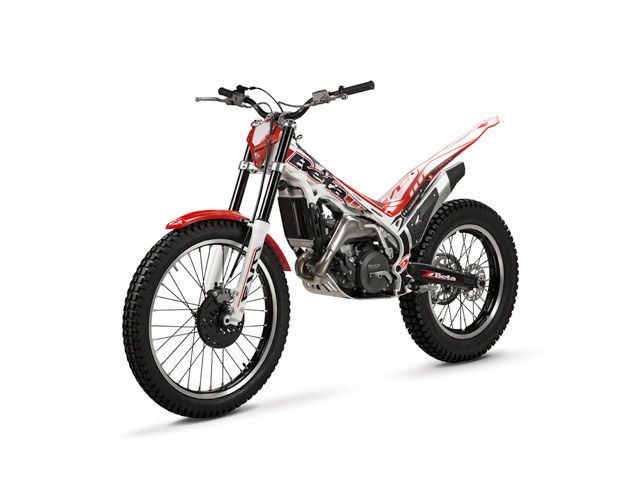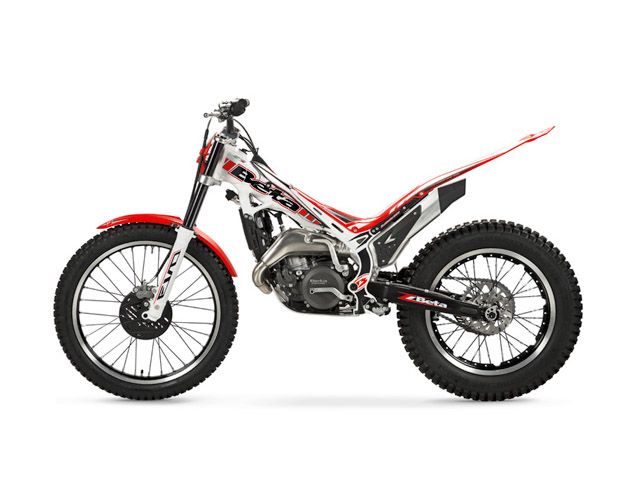The Beta EVO 250 2T mixes lightness with power and agility to reward its rider with first class ride and handling performances.
The 2015 model year comes with a set of new graphics and a few innovations and important updates that help it raise the bar even higher in terms of performance.
Among them you’ll find a lighter rear single shock, a new low-friction gas/oil separator a revised oil tank, a new 38 mm Sachs fork, a new fuel tap and many others.
The bike is built around a 249 cc, single - cylinder, 2-stroke, liquid cooled engine with lamellar induction in the crankcase. The engine’s power is kept in check by a six speed transmission and you also get a 2.8 liter fuel tank.
The motorcycle’s backbone is represented by a single wave aluminium beam frame.
Hit the jump for more information on the Beta EVO 250 2T.
2015 Beta EVO 250 2T
- Make: Array
- Model: 2015 Beta EVO 250 2T
- Engine/Motor: Single-cylinder, 2-stroke, liquid cooled, lamellar induction in the crankcase
- Transmission: 6-speed
- [do not use] Vehicle Model: Array
Overview
Beta EVO 250 2T Model Year 2015
Strong from its many successes on the track and the solid performance of the 2014 Factory models, Beta presents its 2015 EVO trials bike, with new graphics and a series of great innovations and important updates that equip the whole range, regardless of engine size, with higher performance and greater uniformity.
The new 2015 EVO 2T is equipped with a totally revolutionised and more lightweight rear single shock. Fluidity and reactivity are greatly improved thanks to the new low-friction gas/oil separator and the new interior body finish. The oil tank, coaxial to the gas tank, has greater capacity and offers important benefits in terms of stability and resistance to high running temperatures. The new shock is also equipped with a gas charge valve that allows for simple maintenance of the internal elements. The 38 mm Sachs fork, with new white covers, features some improvements inherited from the 2014 Factory model and benefits from both the shortening of the rods (-5.5 mm), for a reduction in weight, the progression and improvement of the more aggressive riding set-up, and a more lightweight spring register cap.
A new fuel tap has been introduced, with new ergonomics that facilitate access to the knob, and allow for the shortening of fuel lines, improving their arrangement.
On the EVO 250 2T and 300 2T, a new 12-pole ignition is introduced, with various new features. The reverse mounting of the flywheel means that rotating masses are centred, for increased agility. Thanks to the 12-pole system, greater electric power is available, to the benefit of the electric fan that can remove heat more quickly. The new ignition layout is completed with a magnesium alloy flywheel cover which functions as a stator support, joined at the crankcase by a gasket to ensure a watertight seal for the flywheel chamber.
There are other new features for the EVO 250 2T and 300 2T in terms of the exhaust, which has a new and longer steel manifold and a new silencer, also longer at the end. This new configuration guarantees greater torque at low speeds, without sacrificing performance at high speeds, and noise reduction with a "fuller timbre".
The EVO 250 2T has the same base as the EVO 300 2T, adopting the same crankshaft with larger shoulders (Ø116.5 mm) and larger crank pins (Ø30 mm), the same crankcases with a larger crank chamber with optimised thickness, the same primary drive with quick gearing, the same water pump mechanism and the same final drive (pinion-crown) to restore the correct total gear ratio. All this makes for a lighter engine, with equivalent inertia, with a clutch that can better support the transfer of torque to the gears, and with a water circuit that has greater capacity.
A significant modification to the engine head has been extended across the whole EVO 2T range, facilitating the filling and bleeding of the cooling circuit. The 2015 EVO range also includes the 250 4T and 300 4T versions, that do not undergo any technical modifications with respect to the successful version of the previous year, offering the perfect balance between power and great manoeuvrability.
On an aesthetic level, the white frame inherited from the 2014 Factory model stands out, as does the new series of plastic parts and graphics, that harmoniously combine red, black and white, perfectly in line with the 2015 Beta family look introduced with the RR Enduro range. Young trials riders can choose the EVO 80 Senior with front wheel from 21" (11-16 years) and the EVO 80 Junior with front wheel from 19" (9-11 years). Both have a top-level chassis and exciting graphics, just like their older EVO sisters.
Specifications
|
Engine |
Single-cylinder, 2-stroke, liquid cooled, lamellar induction in the crankcase |
|
Bore |
72,5 mm |
|
Stroke |
60,5 mm |
|
Displacement |
249,7cc |
|
Compression ratio |
8,9:1 |
|
Ignition |
Electronic Hidria 12V - 110W |
|
Spark plug |
NGK BPR7 ES |
|
Lubrication |
mix with fuel 1,5 % (synthetic oil) |
|
Feeding |
with carburettor |
|
Carburettor |
Keihin PWK ø 28mm |
|
Spark advance |
Variable |
|
Clutch |
Wet multi-disc clutch with cush-drive rubber |
|
Primary trasmission |
Z. 22/69 |
|
Transmission |
6 speed |
|
Secondary trasmission |
Z. 10/42 |
|
Engine oil |
SAE 20W/30 (550 cc) |
|
Frame |
Single wave aluminium beam |
|
Wheel base |
1305 mm |
|
Max length |
1990 mm |
|
Max width |
850 mm |
|
Max height |
1115 mm |
|
Seat height |
660 mm |
|
Ground clearance |
310 mm |
|
Footrest height |
348 mm |
|
Fuel tank capacity |
2,8 l. |
|
Reserve |
0,5 l. |
|
Cooling system capacity |
600 cc |
|
Front suspension |
Hydraulic fork with ø38 mm shaft |
|
Rear suspension |
Hydraulic monoshock |
|
Shock absorber stroke |
62 mm |
|
Front wheel travel |
165 mm |
|
Rear wheel travel |
180 mm |
|
Front brake |
disc ø185 mm with 4 piston caliper |
|
Rear brake |
disc ø160 mm with 2 piston caliper |
|
Front rim |
21 x 1,6 - 32 holes |
|
Rear rim |
18 x 2,15 - 32 holes |
|
Front tyre |
2,75 - 21 |
|
Rear tyre |
4.00 R 18 |
Quotes
"The Evo 250 now has a new crankshaft that has narrower yet larger diameter crank flywheels. This along with the new engine cases provides more spining inertia while also moving more mass to the center of the engine. This system is shared with the 300 and was found on last season's 300 Factory Edition as well." -- mossyrocktrials




